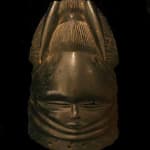Sande Society Mende Helmet Mask, 20th Century CE
Wood
11
SP.501 (LSO)
This outstandingly elegant helmet mask was made by the Mende people of Sierra Leone. It pertains to the Sande women’s initiation society, the only all-female masking society in Africa. It...
This outstandingly elegant helmet mask was made by the Mende people of Sierra Leone. It pertains to the Sande women’s initiation society, the only all-female masking society in Africa. It is a tall, slender and highly ornate example of the genre. The face is, as per usual, narrow from nose-bridge to chin, with slit eyes, a short nose and a pouting, thin-lipped mouth. The base one third of the mask is formed into a series of neck rings, giving way to a very elaborate coiffure that is vertically oriented to the sides, controlled frontally by the fringe which has been draped over the top and attached into position. The front of the coiffure is decorated with two peg-like appendages, perhaps representing hairpins. The bodies of hair are separated by beading that is also present on the lateral aspects of the forehead. Various of these elements have specific meaning. Complex hairstyles are considered beautiful by the Mende, while banding separating face from hair represents fecundity and attractiveness. The neck rings represent water, which is the home of the “Now” spirit (see below).
While currently being marginalized by pressure from Islamic conventions concerning the figurative in art, Mende society was originally controlled by the Sande group. They were charged with responsibility for a sacred medicine known as halei, which was bestowed by deities upon the Mende and their close neighbours, the Gola. The power of halei was displayed during “Now” dancing masquerades, which were performed using these masks and long, dark costumes, although the actual secrets of halei were never divulged. There were various levels of Sande initiation, each with its own mask. The more ornate the mask, the higher the grade. Once made and endowed with magic through strategic application of oil and halei materials, the mask stays with the owner until she retires, dies, or is promoted.
These masks are rare and beautiful pieces of socially important African art, and this is an exceptional example of the genre.
While currently being marginalized by pressure from Islamic conventions concerning the figurative in art, Mende society was originally controlled by the Sande group. They were charged with responsibility for a sacred medicine known as halei, which was bestowed by deities upon the Mende and their close neighbours, the Gola. The power of halei was displayed during “Now” dancing masquerades, which were performed using these masks and long, dark costumes, although the actual secrets of halei were never divulged. There were various levels of Sande initiation, each with its own mask. The more ornate the mask, the higher the grade. Once made and endowed with magic through strategic application of oil and halei materials, the mask stays with the owner until she retires, dies, or is promoted.
These masks are rare and beautiful pieces of socially important African art, and this is an exceptional example of the genre.



